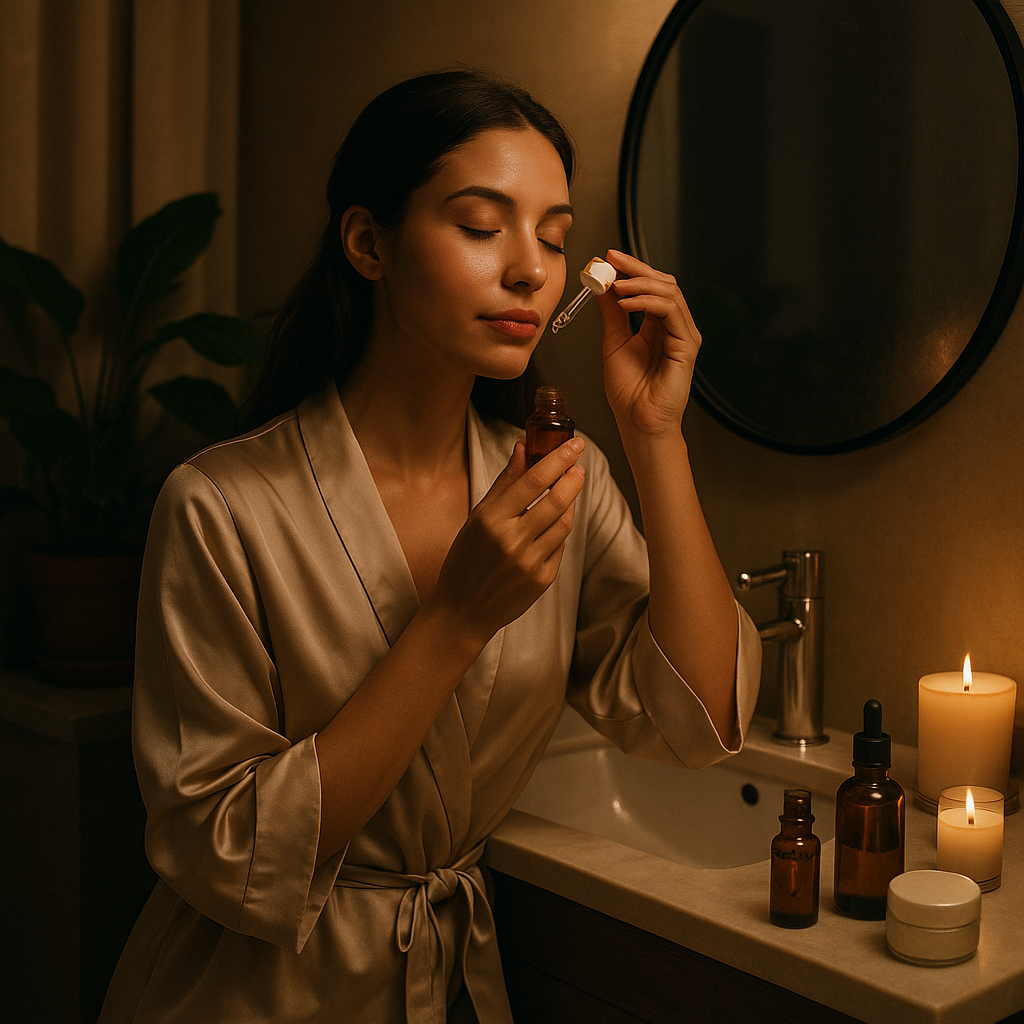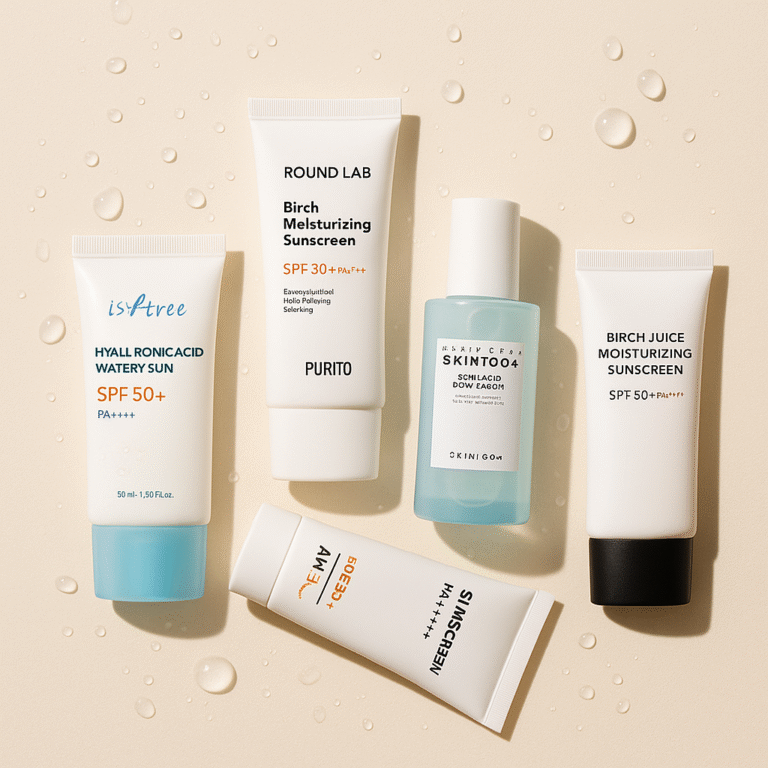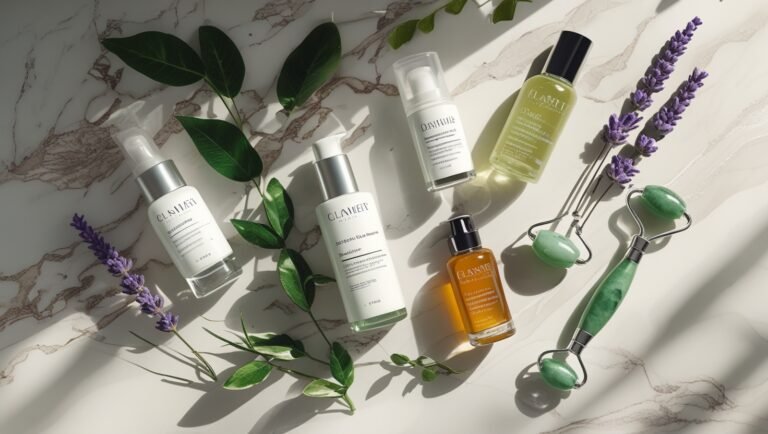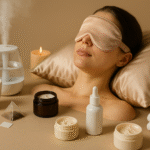Introduction
It’s no secret that a consistent night routine can be a game-changer for your skin’s health and appearance. While you’re asleep, your body—especially your skin—undergoes repair, renewal, and detoxification. That means what you do before you lay your head on the pillow can directly impact how you look when you wake up. Skipping the right steps might mean missing out on the radiant, glowing skin you’ve been working so hard for.
This guide breaks down seven non-negotiable steps that will transform your skin overnight and help you wake up looking refreshed and luminous.

Affiliate Disclaimer: This post contains affiliate links. I may earn a small commission if you buy through them—at no extra cost to you. Thanks for supporting this blog!
The Science Behind Night Repair
During sleep, your body enters a restorative mode, and your skin takes full advantage. Cellular turnover increases, collagen production is stimulated, and oxidative stress is repaired. This process is heavily influenced by the body’s circadian rhythm, a 24-hour internal clock that regulates numerous biological functions—including your skin’s activity levels.
At night, the skin is more permeable, making it the ideal time to apply potent treatments. Melatonin, a hormone released in the dark, has antioxidant properties that combat free radicals. Growth hormone, also more active at night, assists in cellular regeneration and tissue repair. When you align your skincare with this natural rhythm, you enhance its effectiveness significantly.
Step 1: Cleanse Thoroughly
This is the foundation of your entire routine. Going to bed without properly cleansing your face can lead to clogged pores, breakouts, and a dull complexion. Throughout the day, your skin collects a mix of makeup, sunscreen, sweat, dirt, and environmental pollutants. Failing to remove these impurities blocks your skin’s ability to repair overnight.
Start with an oil-based cleanser to dissolve makeup and sunscreen, followed by a water-based cleanser to remove any remaining residue—a method known as double cleansing. For dry skin, opt for hydrating formulas with ceramides or glycerin. Oily or acne-prone skin may benefit from salicylic acid or tea tree oil-based cleansers. No matter your skin type, gentle circular motions and lukewarm water are key for an effective cleanse without irritation.
Recommended Product: Heimish All Clean Balm
Step 2: Gentle Exfoliation (2–3 Times a Week)
Exfoliation helps slough off dead skin cells, unclog pores, and promote a brighter, smoother complexion. Nighttime is the best time to exfoliate because your skin has the chance to recover and regenerate while you sleep. However, it’s important not to overdo it, as excessive exfoliation can cause irritation and damage your skin barrier.
There are two main types of exfoliants: physical and chemical. Physical exfoliants use granules or brushes to manually scrub the skin, while chemical exfoliants—like AHAs (glycolic acid, lactic acid) and BHAs (salicylic acid)—gently dissolve dead skin cells. For most skin types, chemical exfoliants are less abrasive and more effective, especially when used at night. Limit exfoliation to 2–3 times per week and always follow with hydration.
Recommended Product: Paula’s Choice Skin Perfecting 2% BHA Liquid Exfoliant
Step 3: Hydrating Toner or Essence
After cleansing or exfoliating, your skin needs to be rebalanced and prepped for the next steps. A hydrating toner or essence restores the skin’s pH levels and enhances the absorption of serums and moisturizers that follow. Think of it as giving your skin a quick drink of water before the real nourishment begins.
Look for toners or essences containing humectants like hyaluronic acid, glycerin, and panthenol. These ingredients draw moisture into the skin and help maintain plumpness. Apply with your hands or a cotton pad by gently patting it into your skin. Avoid toners with alcohol, which can be drying and counterproductive, especially at night.
Recommended Product: SK-II Facial Treatment Essence
Step 4: Repairing Serums
Nighttime is prime time for targeted treatments, and serums are where the magic happens. These concentrated formulas deliver active ingredients deep into the skin to help repair, firm, and brighten while you rest. The right serum can dramatically improve skin texture, tone, and overall appearance over time.
Key ingredients to look for include retinol (boosts collagen and cell turnover), peptides (repair and firm), niacinamide (brightens and strengthens the skin barrier), and antioxidants (combat free radical damage). Apply serums in order of lightest to heaviest consistency, and allow each to absorb fully before layering the next. If you’re new to actives like retinol, start slow—2–3 nights a week—and always follow with moisturizer.
Recommended Product: The Ordinary Retinol 0.5% in Squalane
Step 5: Eye Cream for Delicate Areas
The skin around your eyes is thinner and more sensitive than the rest of your face, making it one of the first areas to show signs of aging, fatigue, and dehydration. Eye creams are specially formulated to address concerns like puffiness, dark circles, and fine lines without irritating this delicate area.
Ingredients such as caffeine (to reduce puffiness), peptides (to firm), hyaluronic acid (to hydrate), and vitamin C (to brighten) are commonly found in effective eye creams. To apply, use your ring finger to gently tap a small amount around the orbital bone—never rub or tug, as this can cause premature wrinkles.
Recommended Product: CeraVe Eye Repair Cream
Step 6: Rich Moisturizer or Night Cream
Locking in moisture is a must for overnight skin recovery. A night cream or rich moisturizer helps create a barrier that seals in all the active ingredients you’ve applied and prevents water loss while you sleep. This step also provides comfort and nourishment, especially for dry or compromised skin.
Understanding the difference between moisturizers is key:
- Occlusives (like shea butter or petrolatum) form a protective layer to lock in moisture.
- Humectants (like glycerin or hyaluronic acid) attract moisture to the skin.
- Emollients (like squalane or ceramides) smooth and soften the skin.
Choose a product that suits your skin type. Oily skin may prefer gel-based formulas, while dry skin benefits from richer, cream-based options.
Recommended Product: CeraVe Skin Renewing Night Cream
Step 7: Overnight Mask (1–2 Times a Week)
When your skin needs a little extra TLC, an overnight mask can take your routine to the next level. These are intensive treatments designed to deeply hydrate, repair, and restore while you sleep. Unlike traditional wash-off masks, overnight masks are left on until morning and typically applied in place of your night cream.
They’re especially beneficial after exfoliation or during dry weather when your skin needs more nourishment. Look for ingredients like ceramides, hyaluronic acid, and calming botanicals such as centella asiatica. Apply a thin, even layer and let it work its magic overnight—you’ll wake up with noticeably softer, plumper skin.
Recommended Product: LANEIGE Water Sleeping Mask
Extra Care: Facial Oils
Facial oils can be a luxurious and highly effective final step in your nighttime routine. They help lock in moisture, nourish the skin, and provide antioxidant protection. Contrary to popular belief, facial oils are not just for dry skin—there’s an oil for every skin type.
For dry or mature skin, look for richer oils like rosehip, argan, or marula oil, which are packed with fatty acids and vitamins. Oily or acne-prone skin may benefit from lighter, non-comedogenic oils like jojoba, squalane, or grapeseed oil, which can actually help balance sebum production.
Facial oils should be applied after moisturizer to seal everything in. Just 2–3 drops are enough—gently press it into your skin with your fingertips for optimal absorption.
Sleep Hygiene and Its Impact on Skin
Your nighttime skincare routine doesn’t end with the products you apply—it extends to how and where you sleep. Poor sleep hygiene can undo the benefits of even the best skincare regimen. Clean, breathable pillowcases (preferably silk or satin) help prevent bacteria buildup and reduce friction that can lead to fine lines or breakouts.
Your sleeping position also matters. Sleeping on your stomach or side can cause creases that may turn into wrinkles over time. Try sleeping on your back to minimize pressure on your face. Also, ensure you’re getting 7–9 hours of quality sleep. Sleep is when your skin’s regenerative processes are most active, and lack of rest can lead to dullness, puffiness, and dark circles.
✨ Want to upgrade your beauty sleep? Explore satin pajamas set, skin-friendly sleepwear that doesn’t just feel good—but supports your skincare goals too. Breathable, soft, and gentle on your skin, the right sleepwear can elevate your entire nighttime ritual.
Nutritional Support for Night Repair
What you eat and drink in the evening can significantly affect your skin’s overnight repair process. Nutrient-rich foods support cellular regeneration and combat inflammation. Focus on incorporating skin-loving vitamins and minerals like vitamin C, E, A, zinc, and omega-3 fatty acids into your dinner or late-night snacks.
Some great options include berries, nuts, avocados, fatty fish, and leafy greens. Hydration also plays a critical role—sip herbal teas like chamomile or spearmint for relaxation and anti-inflammatory benefits, and make sure you’re well-hydrated before bed. Avoid heavy, greasy foods or excessive sugar at night, as they can trigger inflammation and skin issues while you sleep.
Managing Stress and Hormonal Balance
Chronic stress can wreak havoc on your skin, disrupting your hormone levels and increasing inflammation. Elevated cortisol—the body’s primary stress hormone—can lead to breakouts, dryness, and even premature aging. Managing stress before bed not only improves your sleep quality but also supports your skin’s ability to repair and regenerate overnight.
Incorporate simple relaxation techniques into your nighttime routine, such as meditation, deep breathing exercises, journaling, or listening to calming music. Skincare habits that support hormonal balance include using gentle, fragrance-free products, avoiding harsh scrubs, and introducing adaptogenic ingredients like centella asiatica or calendula to calm stressed skin.
Avoid These Common Nighttime Skincare Mistakes
Even with the best intentions, certain missteps can sabotage your skincare routine. One common mistake is over-layering too many products, which can overwhelm the skin and cause irritation or breakouts. Stick to a streamlined routine focused on your skin’s specific needs.
Another mistake is not patch testing new products. Even gentle ingredients can cause unexpected reactions if your skin isn’t accustomed to them. Always do a small test on your inner arm or jawline before introducing something new.
And perhaps the most harmful error? Sleeping with makeup on. This clogs pores, increases the risk of acne and dullness, and accelerates aging. No matter how tired you are, always cleanse your face thoroughly before bed.
Morning-After Routine
Your nighttime routine sets the stage, but your morning routine seals the results. Start your day by gently cleansing your face to remove any residue from your night products and skin’s natural overnight processes. This helps prevent clogged pores and preps your skin for the day ahead.
Follow up with a hydrating toner or mist, a lightweight serum (such as vitamin C for antioxidant protection), and a daily moisturizer. Most importantly, never skip SPF—even if you spent the night indoors. UV rays can penetrate windows and still affect your skin, and protection is crucial for maintaining that overnight glow.
Assess your skin each morning. If it looks calm, hydrated, and refreshed, your routine is working. If you notice breakouts, dryness, or irritation, it may be time to adjust your products or frequency of use.
Conclusion
Creating a consistent, intentional nighttime skincare routine isn’t just self-care—it’s science-backed skin care. Your skin works hardest at night to repair, renew, and reset, and the choices you make before bed can mean the difference between dullness and a radiant morning glow.
The seven steps outlined here—cleansing, exfoliating, hydrating, repairing, treating the eyes, moisturizing, and masking—cover all the bases for effective overnight skincare. By supporting these steps with healthy sleep habits, a balanced diet, and stress management, you’re creating the optimal environment for your skin to thrive.
Everyone’s skin is unique, so take time to personalize your routine. Start with the basics, listen to how your skin responds, and adjust as needed. With commitment and care, the glow you wake up with won’t just be from good dreams—it’ll be from great skin.
1. Can I skip moisturizer if I use a facial oil at night?
No. Facial oils are excellent for sealing in hydration, but they don’t hydrate on their own. Always apply moisturizer first to provide moisture, and follow with an oil to lock it in.
2. How long should I wait between applying my serum and moisturizer?
Wait about 30–60 seconds or until the serum has absorbed into the skin. This ensures the next layer doesn’t dilute or disrupt the effectiveness of the serum.
3. Is it okay to use retinol and exfoliants on the same night?
Generally, no—especially if you’re new to actives. Using both on the same night can irritate and sensitize your skin. Instead, alternate nights or use one in the morning and the other at night under professional guidance.
4. Do I need a different routine for different seasons?
Yes. Your skin’s needs can vary with the weather. For example, in winter, you may need richer moisturizers and fewer exfoliating treatments, while summer may call for lightweight products and more sun protection.
5. What’s the best time to apply night skincare products?
Apply your night routine at least 30–60 minutes before bed. This gives your skin time to absorb the products and prevents them from rubbing off onto your pillowcase.
Additional Resource
For a simple and effective skincare regimen, check out this guide: 5-Minute Skincare Routine







